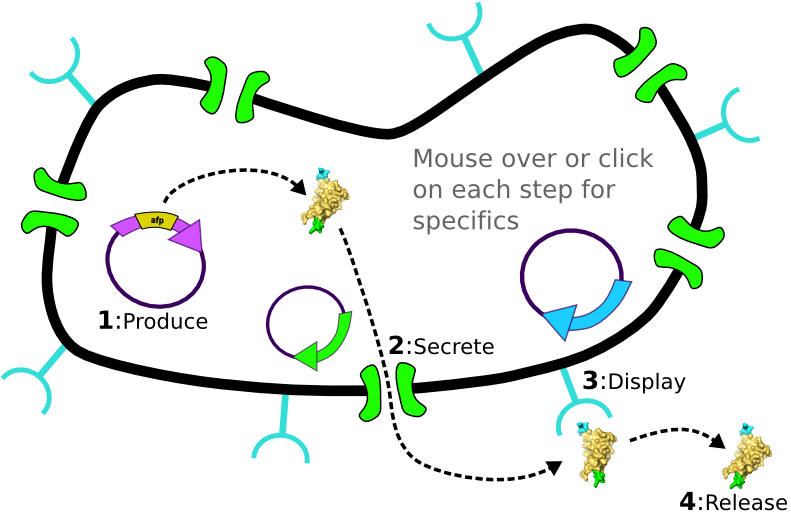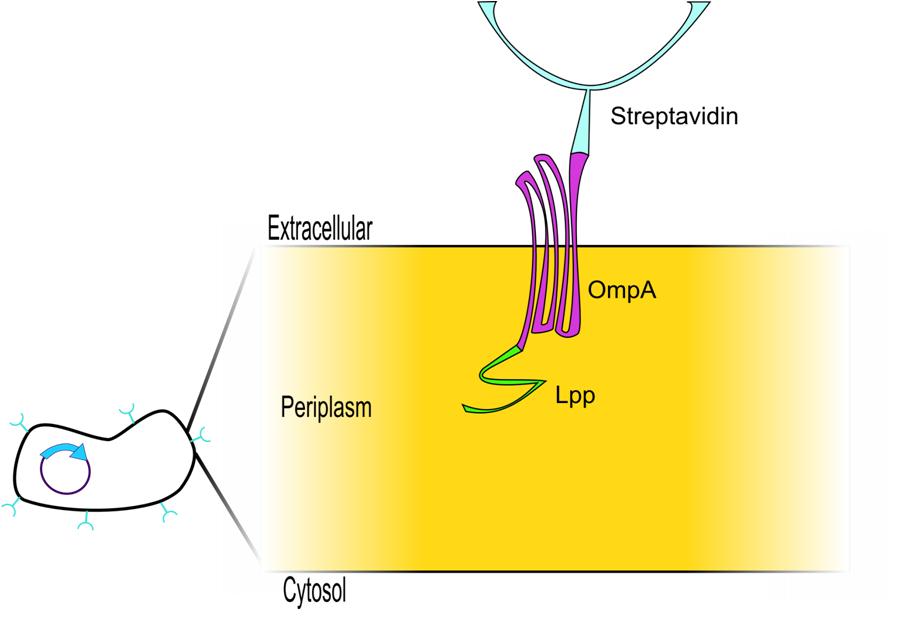Team:Washington
From 2009.igem.org
| Home | The Team | Project Description | Notebook | User Guide | Goals and Accomplishments |
|---|
|
[1] Target Expression Vector produces fusion protein of interest. [2] Secretion Tag on fusion protein is recognized by secretion system and transported to extracellular space. [3] Nano-Tag on fusion protein is recognized by protein on cell surface and binds non-covalently to cell. [4] Competing binder for surface protein releases protein of interest into supernatant.
|
Contents |
Display System
Background
This display system was biobricked by Harvard in 2006. They submitted four biobricks which where all variations on the same theme. All four are fusion proteins which have a LPP signal peptide, either one or five trans-membrane ompA, and either monomeric or dimeric streptavidin. All the variaitons and the resulting biobricks are shown below.
| Bio Brick | OmpA trans-membrane domains | Type of Streptavadin |
|---|---|---|
| J36848 | 1 | monomeric |
| J36849 | 1 | dimeric |
| J36850 | 5 | monomeric |
| J36851 | 5 | dimeric |
A basic graphic of the structure of this display system is shown below:
They used a LPP signal peptide (green) to cause the fusion protein to migrate to the outer surface. Though ompA is normally a membrane bound protein, often it is only expressed in the periplasm, the LPP signal ensures it is exported all the way to the cell membrane. This LPP-ompA system is a well characterized protein for displaying enzymes on the surface of the cell. This system has been used to display the following proteins on the surface of the cell:
- Chitin binding domains
- ...
- ...
- ...
Thus we considered it only logical to use this system to display sreptavadin on the surface of the cells. We choose streptavadin because of its low affintiy for the nano tag on our target fusion protein, which can be displaced by the small molecule biotin. Streptavadin is known to have a high affinity for binding the small molecule biotin. The picture below shows the biotin streptavadin complex.
In order to characterize how these parts worked, we ran the follwoing tests:
- Western against the his tags on all of these proteins
- Micrscope Assay
- Flow Cytometry Assay
Western
The goal of this experiment was to make sure that the proteins were being expressed in our cell lines, and also to make sure that they were the correct length. Here is our procedure for the preparation of the western.
Procedure
- Set up overnights of parts 48-51
- Dilute 1 ul overnight into 1ml
- Add 1 mm IPTG and let grow for four hours
- After cells have all grown up uniformly start boiling water for the boil step
- Add 100uL of overnight to a 1.5mL tube
- Pellet by spinning at max speed for 30 secs in the microcentrifuge
- discard supernatent
- Pull an aliquot of 5x sample loading buffer out of the freezer and thaw
- Add 20uL BME to aliquot
- Resuspend samples in 50uL sample loading buffer (pipette up/down)
- Boil samples for 10 minutes
- While boiling, prepare 500mL 1x SDS buffer:
- 50mL 10x buffer to 450mL water
- Take a gel out of the fridge and and put it in the gel box (keep the gel container for staining!!!)
- Pour the mixed buffer solution into the half of the gel box that the gel is in
- Remove the gel comb
- Fill the little container on the top of the gel until it's about 0.5 cm from the top with buffer
- Remove any bubbles in the wells
- Spin down samples for a few seconds
- Vortex samples
- Load 3uL into each well
- Load 10uL of ladder in appropriate wells
- Run at 180V until the dye is about to fall off the gel
Results
File:Western.jpg I know this is not annotated, but it will be on the real site
The expected values of each of these proteins are shown in the table below:
| Bio Brick | Length (in kD) |
|---|---|
| J36848 | 21478.7 |
| J36849 | 34600.9 |
| J36850 | 31215.4 |
| J36851 | 44972.3 |
From this data one can see that all of the bands from our proteins came out to be in the right locations. Thus our protein was being expressed.
Microscope Assay
The goal of this experiment was to see if we could confirm the presence of streptavadin on the outside of our cell. We wanted to do this using a biotyntalated flourophore. We expected that this flourophore would bind to the streptavadin on the outside of the cell in such a high level that we would be able to detect it under a high powered florescence microscope. As a positive control we used streptavadin coated beads which were roughly the same size (with respect to volume) as our cells (except spherical).
Procedure
- Set up overnights of parts 48-51. Let grow overnight.
- Dilute 1 ul overnight into 1ml
- Add 1 mm IPTG and let grow for four hours
- After cells have grown up, place in flourophore (1 um) and allow time to bind (1 hour)
- Also place 1 ul beads in 1 ml along with 1 ul flourophore.
- Allow beads to bind to flourophore, then spin beads down, remove supernatent and replace with 1 ml water.
- Next place the cells and the beads under the microscope
Data
From this data we can see that while the positive control did have a visible increase in florescence around the outside, the cells did not show any such increase.
Flow Cytometry
The goal of this experiment was to see how the biotin bonded to streptavadin over a whole population of cells. Where as the Microscope experiment looked at a few localized cells, we set the cytometer to look 50,000 cells or beads and read the resulting florescence.
Procedure
- Set up overnights of parts 48-51. Let grow overnight.
- Dilute 1 ul overnight into 1ml
- Add 1 mm IPTG and let grow for four hours
- After cells have grown up, place in flourophore (1 um) and allow time to bind (1 hour)
- Also place 1 ul beads in 1 ml along with 1 ul flourophore.
- Allow beads to bind to flourophore, then spin beads down, remove supernatent and replace with 1 ml water.
- Read the samples through the flow cytometer
Data
File:2009-08-07 1uL Beads + Fluoro & Control.png File:2009-08-07 51s.png
Again this data showed us that we did not have any appreciable binding occurring with our display system to biotin at the global level
 "
"

